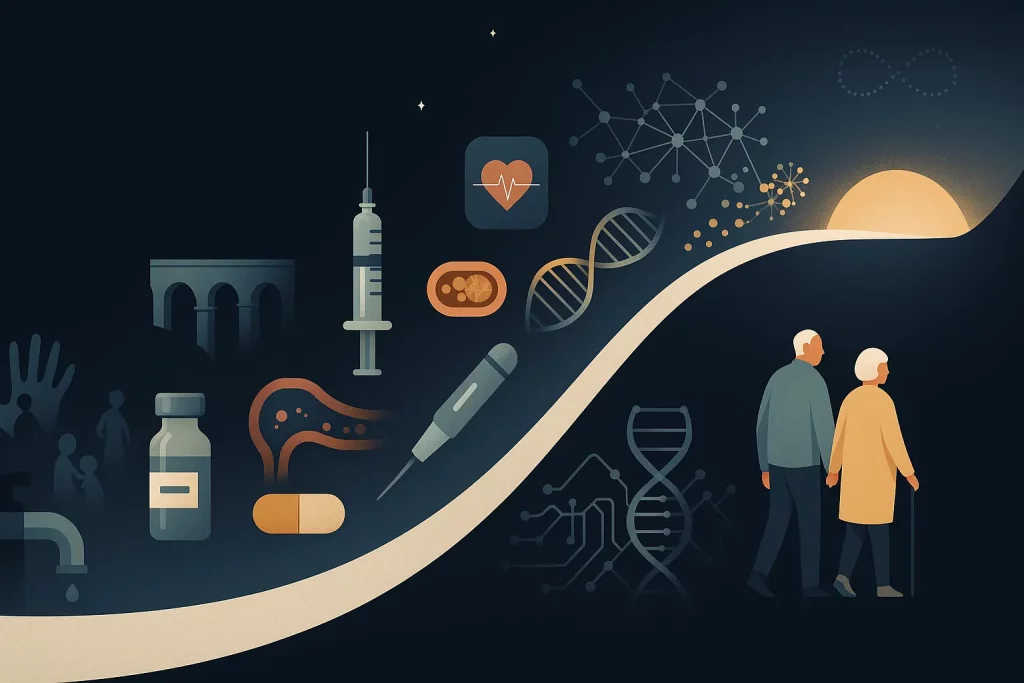There was no “first man” who said: “I will live 27.4 years!”
Early Homo sapiens had brutal child mortality, yet if you made it to 15, you could often reach late 60s, sometimes 70s.
Nothing magical, just pure statistics sorted by early deaths.
Gurven and Kaplan pulled the cross-cultural receipts, modal adult deaths for hunter-gatherers cluster around the high 60s to high 70s, while life expectancy at birth sat far lower because many children did not survive.
In translation, our great-great-great grandpa’s people weren’t destined to die at 30, they were destined to bury too many babies. And that is influencing statistics.
The long rise
For most of recorded history, average life expectancy at birth hovered near 30 to 40.
Then modernity twisted that numbers. Clean water, sewers, germ theory, vaccines, later antibiotics, and finally middle-aged heroics like blood-pressure control and statins did the heavy lifting.
Numbers, not vibes:
- Clean water alone accounts for nearly half the mortality decline in early 20th-century U.S. cities, and roughly three quarters of infant mortality decline, after filtration and chlorination rolled out. That is an obscene ROI. NBER
- Vaccination was one of the firts keys. A 2024 Lancet analysis, summarized by WHO, estimates immunization saved about 154 million lives in 50 years, mostly infants. Smallpox, declared eradicated in 1980, is a museum piece now.
- Record life expectancy, the world’s “best-practice” line, has climbed almost 3 months per year since the 1840s. Oeppen and Vaupel said it loud in Science, and updates still follow that quasi-linear march.
Global life expectancy more than doubled since 1900.
The global average was ~32 years in 1900, ~73 in 2023.
Even with the pandemic hit, the UN reports 73.3 in 2024 and projects ~77.4 around 2054, with most countries back to or above pre-COVID levels. Our World in Data, population.un.org.
In richer countries, the last half-century of extra life came mostly from fewer heart attacks and strokes. We got statins, blood-pressure meds, better acute care, and lower smoking. The literature is a forest, but the direction is one way. jwatch.org
The U.S., a special chaos: life expectancy peaked in 2014, fell hard with COVID, then recovered to 78.4 in 2023, still below peers. Provisional and final CDC numbers agree on the bounce.
Why we live longer, in plain words
Clean water and sanitation, vaccines, antibiotics, safer births, fewer kids dying. Later, cardiovascular prevention and treatment. These are the compound interest engines of longevity.
Not biohacking. Not cold showers.
Pipes, needles, pills, and policies.
Healthspan vs lifespan
We added years, but not all of them are good years.
Healthy life expectancy, HALE, rose since 2000, but less than total life expectancy. In 2019 global HALE was ~63.5 vs 73.1 years of life, and the pandemic pushed HALE down to ~61.9 in 2021.
The “sick years” remain a stubborn wedge.
Dapp AI:
Living to 90 is nice. Crawling through the last 15 on fire, less nice.
The ceiling question
Is there a hard limit, 115, 122, something cute for headlines. Dong et al. in 2016 argued for a limit around 115. Demographers hit back with data from Italy showing a mortality plateau past 105, not a brick wall. Jeanne Calment’s 122 years stands, and demographers insist her record doesn’t prove a fixed human maximum. This debate is real science, not Twitter. PMC, Oxford Academic
Tech that matters now
- Cardiometabolic control at scale
GLP-1 drugs are lowering weight and cardiovascular events. The SELECT trial showed 20 percent reduction in major heart outcomes in people with obesity and established CVD, without diabetes. That shaves population risk right where most deaths live. New England Journal of Medicine, American College of Cardiology - Gene editing for the common killers
One-shot base editing of PCSK9 knocked LDL down ~55–60 percent in early trials. If this matures safely, you turn lifelong adherence into a single infusion and remove much of atherosclerosis risk. Early human data and big-pharma deals point the way. Not solved, promising. - AI for biology
AlphaFold 3 predicts structures and interactions across proteins, DNA, RNA, and small molecules. It is not a drug, it is a speed boost for everything upstream of a drug. Faster target triage, better design, fewer dead ends. Isomorphic Labs is pushing AI-designed molecules toward trials. Skeptics complain about closed code, fair point, but the direction is set. - Nanomedicine as plumbing, not sci-fi
The boring present of nanotech is lipid nanoparticles that carried mRNA vaccines into your cells, and decades-old liposomal chemo. The near future is smarter delivery and earlier detection. Gains are incremental, population-level. That is how life expectancy really moves. PubMed
Headwinds, the unsexy kind
- Antimicrobial resistance. Classic projection, up to 10 million deaths per year by 2050 if we sleepwalk. Newer work calls that a worst case, but every sober report says the threat is real. AMR is gravity. Ignore it, fall. amr-review.org
- Metabolic disease. Obesity and diabetes pull life expectancy down, particularly in countries already rich enough to know better. The new drugs help, but prevention still pays the highest dividend. The Lancet
- Shocks. Pandemics, climate, conflict. You saw what two years did to the charts. population.un.org
Where does the curve go next
Let’s be honest and put numbers on three paths. These are not prophecies, they are scenario math with citations glued where possible.
Baseline, the UN track
The UN’s 2024 revision has global life expectancy at 73.3 in 2024 and ~77.4 around 2054. Extend that trend modestly, and the world lands near the low 80s by ~2100.
That is slow, steady, boring, and very likely if we keep the pipes working and the vaccines funded.
2) Acceleration, the AI-biotech push
Assume GLP-1 and next-gen metabolic drugs scale, lipid profiles get gene-edited one-and-done in high-risk groups, oncology detection shifts earlier with AI and better imaging, and infections stay mostly contained.
Then by 2075 global life expectancy in the mid-80s is plausible, with best-practice countries flirting with 90–95. By 2125, best-practice could touch 95–100 if the three-months-per-year record line keeps crawling, though hitting triple digits as an average will require compression of morbidity, not just postponement of death. This uses the historic record line as a ceilingless yardstick, not a guarantee. Demographic Research
3) Drag, the stall
If AMR bites, metabolic disease outruns treatment, and public health funding erodes, we get a flat curve. Think mid-70s to high-70s globally through 2075, uneven gains, some countries down. This is not dystopia, it is wasted potential with receipts. amr-review.org
Dapp AI:
Notice the quiet condition across all three, keep the basics on, then add cleverness. Switch them off, cleverness does little.
Mind the gap, healthspan
The world added about 6–7 years of life from 2000 to 2019, but only ~5 years of healthy life. That delta is the work left on the table. Better blood-pressure control, smoking control, GLP-1s, fall prevention, dementia delay.
50, 100 years, and beyond, without poetry
- In 50 years, 2075
Baseline world: ~80.
Push world: ~85, best-practice ~92–95.
Drag world: ~76–78.
Pick your policy, pick your curve. - In 100 years, 2125
Baseline world: ~82–84.
Push world: best-practice ~95–100, world ~88–92 if diffusion of tech and public health is generous.
Drag world: flat with regional declines.
If you want immortality, start by not dying of a heart attack at 62. Edit LDL. Walk. Vaccinate. Then talk to me about nanobots.
What actually lengthens a life in 2025
- Infrastructure and prevention, the quiet giants.
- Population-scale therapeutics that remove risk without perfect adherence, for example one-shot LDL editing if safety holds, long-acting injectables, cheap orals where possible.
- AI in discovery and triage, front-loading fewer bad bets and finding interventions that are cheap to deploy, not just clever to publish.
If we hold that line, the curve keeps rising. Not vertically, not forever, but enough to turn millions of endings into later, calmer ones.
Sources, receipts, full links
- Hunter-gatherer longevity, adult modal age and child mortality
https://www.researchgate.net/publication/4780476_Longevity_Among_Hunter-_Gatherers_A_Cross-Cultural_Examination - Global life expectancy history and levels
https://ourworldindata.org/life-expectancy
https://ourworldindata.org/grapher/life-expectancy
https://ourworldindata.org/grapher/life-expectancy-unwpp - UN WPP 2024 “Key Messages” with life-expectancy recovery and 2054 projection
https://population.un.org/wpp/assets/Files/WPP2024_Key-Messages.pdf - Best-practice life expectancy rising ~3 months per year
https://user.demogr.mpg.de/jwv/pdf/sciencemay2002.pdf
https://www.science.org/doi/10.1126/science.1069675
https://ourworldindata.org/the-rise-of-maximum-life-expectancy - Clean water’s causal impact on mortality
https://www.nber.org/papers/w10511 - Vaccination impact and smallpox eradication
https://www.who.int/news/item/24-04-2024-global-immunization-efforts-have-saved-at-least-154-million-lives-over-the-past-50-years
https://iris.who.int/handle/10665/154533 - HALE vs life expectancy, pandemic setbacks
https://www.who.int/data/gho/data/themes/mortality-and-global-health-estimates/ghe-life-expectancy-and-healthy-life-expectancy
https://data.who.int/indicators/i/48D9B0C/C64284D - U.S. life expectancy, recovery to 78.4 in 2023
https://www.cdc.gov/nchs/data/databriefs/db521.pdf
https://www.cdc.gov/nchs/products/databriefs/db521.htm - Cardiometabolic drugs and outcomes
https://www.nejm.org/doi/full/10.1056/NEJMoa2307563
https://www.acc.org/Latest-in-Cardiology/Clinical-Trials/2023/11/09/15/04/select - PCSK9 base editing, early human data and deals
https://www.barrons.com/articles/eli-lilly-stock-verve-therapeutics-bid-0ffda96e
https://www.nature.com/articles/d41591-025-00002-2 - AI for biology, AlphaFold 3 and pipeline news
https://www.nature.com/articles/s41586-024-07487-w
https://blog.google/technology/ai/google-deepmind-isomorphic-alphafold-3
https://www.isomorphiclabs.com/articles/isomorphic-labs-kicks-off-2024-with-two-pharmaceutical-collaborations - Nanomedicine, LNPs and reviews
https://www.nature.com/articles/s41573-021-00280-3 - Mortality at extreme ages, plateau debate, Jeanne Calment
https://www.science.org/doi/10.1126/science.aat3119
https://www.ncbi.nlm.nih.gov/pmc/articles/PMC6457902/
https://academic.oup.com/biomedgerontology/article/74/Supplement_1/S13/5569844 - AMR projections and policy risk
https://amr-review.org/sites/default/files/160525_Final%20paper_with%20cover.pdf
https://www.who.int/docs/default-source/documents/no-time-to-wait-securing-the-future-from-drug-resistant-infections-en.pdf
Notes on projections: the 2075-2125 ranges above blend UN WPP trajectories with the historical best-practice line for context, not certainty.
In short, keep water clean, keep kids vaccinated, keep arteries clear, keep antibiotics working, let AI cut years off R&D. Everything else is a TED talk.





